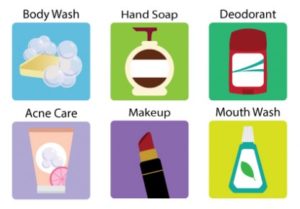Press Highlights
 Triclosan (2,4,4’-tricloro-2’-hydroxy-diphenyl ether) is a synthetic compound classified both as a drug and a pesticide. It is widely used in consumer goods for its broad-spectrum antimicrobial properties. At low doses, triclosan impairs bacterial growth by inhibiting enoyl-acyl carrier protein reductase, an enzyme necessary for bacterial lipid biosynthesis, while at high doses, triclosan is bactericidal, possibly due to cell membrane damage. Triclosan is contained in personal care products, such as toothpaste, deodorants, and soaps, as well as impregnated into materials such as plastics and textiles for use in various consumer goods (kitchenware, clothing, etc.). Moreover, triclosan may be an endocrine disruptor, contribute to the development of antibacterial resistant organisms, or alter the human microbiome.
Triclosan (2,4,4’-tricloro-2’-hydroxy-diphenyl ether) is a synthetic compound classified both as a drug and a pesticide. It is widely used in consumer goods for its broad-spectrum antimicrobial properties. At low doses, triclosan impairs bacterial growth by inhibiting enoyl-acyl carrier protein reductase, an enzyme necessary for bacterial lipid biosynthesis, while at high doses, triclosan is bactericidal, possibly due to cell membrane damage. Triclosan is contained in personal care products, such as toothpaste, deodorants, and soaps, as well as impregnated into materials such as plastics and textiles for use in various consumer goods (kitchenware, clothing, etc.). Moreover, triclosan may be an endocrine disruptor, contribute to the development of antibacterial resistant organisms, or alter the human microbiome.
Since September 2016, it is banned in the United States by the Food and Drug Administration (FDA) – but only in antibacterial soaps. However, they are still found in many other hygiene products, but also in everyday objects that are impregnated to limit bacterial contamination: kitchen utensils, toys, bedding, garbage bags, etc. . In June 2017, 200 scientists and health professionals teamed up to sign the “Florence Statement”, published in Environmental Health Perspectives, which warns that triclosan and triclocarban, a similar product, “should only be used if their positive effects for health are proven.”
The biological mechanism of the impact of triclosan on semen quality is unclear but in vitro studies have demonstrated that triclosan can bind with low affinity with estrogen and androgen receptors and it can adversely affect the male reproductive system by disrupting steroidogenesis. It was found that triclosan disrupts the steroidogenic cascade leading to decreased testosterone synthesis or at high doses, triclosan inhibited testosterone synthesis but only rhCG-induced synthesis, while basal testosterone production remained unaffected. Another finding was the downregulation of testicular levels of mRNA for cytochrome P450scc, cytochrome P450c17, 3β-HSD, 17β-HSD, StAR, AR, and a decreased in vitro activity of testicular steroidogenic enzymes and the decreased levels of serum LH, FSH, cholesterol, pregnenolone, and testosterone.
Accordingly, there is a need for improved understanding of the risks and benefits of triclosan use.
In this study, Jurewicz and colleagues try, for the first time, to highlight the association between environmental exposure to triclosan and male fertility according to semen quality, sperm DNA damage, reproductive hormone level and sperm disomy in adult men.
A total of 315 men who attended infertility clinics for diagnostic purposes were enrolled in the study. Next, after the abstinence period, semen samples were generated, analyzed and assessed according to World Health Organization (WHO 2010) guidelines; Sperm DNA damages was evaluated based on sperm chromatin structure assay; To assess sperm aneuploidy a multicolor FISH analysis was performed; To measure the levels of FSH, testosterone, and estradiol Chemiluminescent Microparticle Immunoassay was used. The triclosan concentration was measured using spot urine samples.
This study shows that triclosan was detected in 84,13% of samples and there is a significant and positive associations observed between the urinary concentrations of triclosan and percentage of sperm with abnormal morphology.
The results of the present study suggest that urinary levels of triclosan increase the percentage of sperm with abnormal morphology. These findings suggest that environmental exposure to triclosan may affect semen quality. This confirms results shown in 2016 who find that the exposure to triclosan was inversely associated with the number of normally morphologic sperm.
Here, Jurewicz and colleagues investigated the association between exposure to triclosan and male fertility measured by semen quality parameters, sperm DNA damage, total sperm disomy, and the level of reproductive hormones. They observed that triclosan exposure can increase the percentage of sperm with abnormal morphology. These findings provide one of the first evidence of adverse effects of triclosan exposure on male fertility. The results of the current study support the hypothesis that endocrine-disrupting chemicals are important factors for declining male semen quality.
More information:
Original article: https://www.ncbi.nlm.nih.gov/pubmed/29214481
Triclosan article: https://www.ncbi.nlm.nih.gov/pubmed/29182464
Florence Statement: https://www.ncbi.nlm.nih.gov/pubmed/28632490

